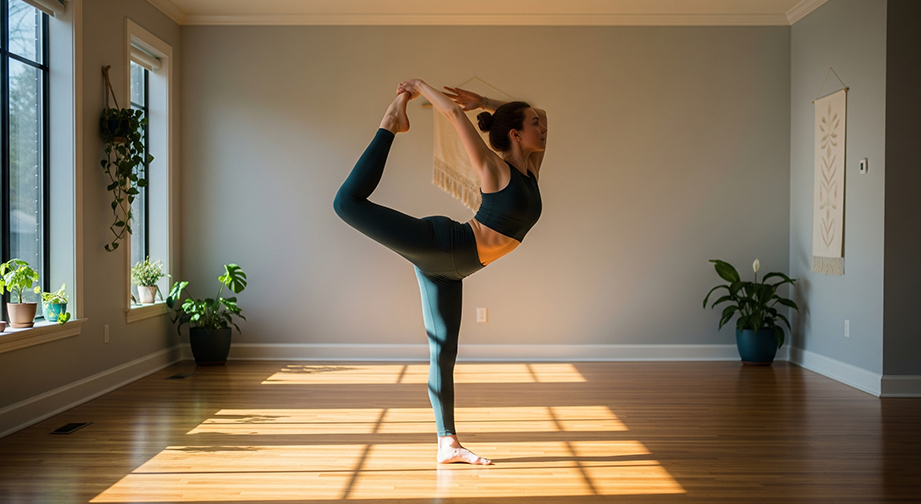Natarajasana (Lord of the Dance Pose): A Complete Guide to This Balancing Yoga Asana
Introduction
Natarajasana, often called the Lord of the Dance Pose or Dancer’s Pose, is a beautiful standing yoga posture that gracefully combines balance, strength, and flexibility. The word "Natarajasana" comes from Sanskrit: “nata” means dancer, “raja” means king or lord, and “asana” means pose. This posture honors the cosmic dancer, Lord Shiva (Nataraja), embodying dynamic energy and balance.
Essence: This asana is all about finding balance between steadiness and openness. It energizes your body and brings a sense of graceful focus.
If you’ve ever felt stiff after sitting too long or crave a confident boost, Natarajasana can be your best friend on the mat—inviting poise, strength, and mindful balance, even on wobbly days.
Step-by-Step Guide to Natarajasana (Dancer Pose)

- Start Standing: Begin in Tadasana (Mountain Pose). Stand tall with feet hip-width apart, spine lengthened, and arms relaxed by your sides.
- Shift Weight: Gradually transfer your weight onto your right foot. Root down through all four corners of the foot.
- Bend Your Left Knee: Bring your left heel toward your left glute. Reach your left hand back and grab the inside of your left foot or ankle.
- Lift and Balance: On an inhale, raise your right arm up alongside your ear. Begin lifting your left foot up and back, allowing your chest and right arm to reach forward.
Breathing pattern: Inhale as you lengthen the torso and arm; exhale as you find steadiness and kick your foot gently upward.
- Find Your Balance: Keep your gaze on a steady spot (drishti). Square your hips and gradually deepen the stretch, bringing your torso slightly forward as your leg rises.
- Hold the Pose: Breathe steadily here for 3–5 breaths or up to 30 seconds.
- Release: On an exhale, gently release your foot and come back to Tadasana. Repeat on the other side.
Modifications for Beginners:
- Use a wall for support or lightly hold a chair with one hand.
- Wrap a yoga strap around your lifted foot if you can’t comfortably reach it.
- Only lift your foot as high as feels safe; focus on keeping your chest lifted rather than height.
To Intensify:
- Hold the raised foot with both hands (full Natarajasana variation).
- Draw the foot higher and deepen the chest/shoulder stretch.
- Lift the gaze upward for more challenge.
Alignment & Safety Tips
- Alignment cues: Keep knees close together as you begin; avoid rotating the lifted knee outward.
- Engage your standing leg, gently hugging the knee cap upward.
- Lift your chest forward and up, avoiding collapsing the lower back.
- Keep hips squared; avoid letting the hip of the lifted leg open outward.
- Common mistakes: Overarching the back, pulling the leg too high, or letting the chest drop. Correct these by maintaining elongation in the spine and lifted heart.
- Safety precautions: Avoid if you experience dizziness, severe balance issues, or acute hip/knee/ankle injuries.
Benefits of Natarajasana
Physical Benefits:
- Improves balance and stability
- Strengthens standing leg muscles and ankles
- Opens up hips, chest, and shoulders
- Enhances flexibility in the back, thighs, and groin
- Lengthens and tones the core and spine
Mental Benefits:
- Encourages focus and mental clarity
- Promotes patience and presence
- Reduces stress through mindful breathwork
Energetic/Chakra Connection:
- Activates the Heart Chakra (Anahata) for openness and compassion
- Stimulates the Root and Sacral Chakras for grounding and creative energy
Contraindications
- Avoid with ankle, knee, hip, or lower back injuries
- Not recommended for people with vertigo or serious balance issues
- If pregnant, only practice with modifications and guidance
Safe alternatives: Try Tree Pose (Vrikshasana) for balance or Bridge Pose (Setu Bandhasana) for a gentler backbend.
Beginner’s Tips & Variations
- Props: Use a strap around your lifted foot or support yourself with a wall.
- Gentle Variation: Keep raised foot lower; focus more on balance than height or depth.
- Advanced Variation: Hold the lifted foot with both hands overhead (full Natarajasana); try closing your eyes for extra challenge.
How to Include Natarajasana in a Yoga Flow
Natarajasana works best in the main phase of your practice, once you’re warmed up and your muscles are ready for a balance challenge.
- Pairs well with: Tree Pose (Vrikshasana) for balancing preparation
- Follows: Downward Dog (Adho Mukha Svanasana) or Low Lunge (Anjaneyasana) for hip and leg readiness
- Complements: Standing Forward Fold (Uttanasana) to release after
Mind-Body Connection
Practicing Natarajasana is a moving meditation, inviting you to be present with your breath and body. Notice the energy in your standing foot and the openness in your chest. This pose connects you to the Heart Chakra, encouraging self-love and graceful awareness.
Summary Box
Asana Name: Natarajasana (Lord of the Dance Pose, Dancer’s Pose)
Level: Intermediate (Beginner-friendly with props/modifications)
Focus Areas: Balance, core, hips, shoulders, legs
Duration: 3–5 breaths (up to 30 seconds per side)
Best Time to Practice: Morning or anytime you need a mindful reset
FAQs about Natarajasana
- Is Dancer's Pose suitable for beginners?
Yes, with support from a wall or a strap, beginners can safely practice Natarajasana. Start slow!
- What if I can’t balance?
Use a chair or wall for support and focus on a spot in front of you. Practicing regularly improves balance over time.
- How often should I include this pose in my routine?
2–3 times per week, or whenever you want to challenge your balance and boost focus.
Remember: Yoga, like Natarajasana, is a journey—not a destination. Even wobbles and falls are part of the dance. Stay playful, listen to your body, and let your practice be an exploration of grace on and off the mat.